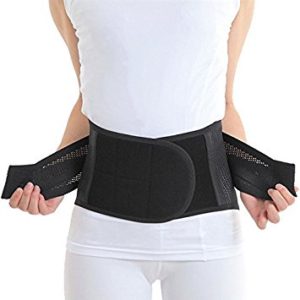
On Low Back Support Belts
Posted on January 25, 2018 at 5:05 pm
I just returned from a relaxing week-long vacation in Cabo San Lucas, Mexico. The ocean was beautiful, the sunsets magnificent, and the tequila sweet, strong and flowing.
My wife and I stayed at a large resort, supported by lots of local workers: gardeners, maids, cooks, waiters, maintenance people, and many others.
As a chiropractor, I could not help but notice that many of the workers were wearing lumbar (lower back) support belts. These are the cloth and Velcro braces that can be wrapped tightly around one’s waist. The reason workers use these is to prevent low back injury, which is the most common work injury.
So, is it a good idea to wear them?
Studies suggest that there is little difference, in terms of incidence of injuries, whether one wears a lumbar support belt or not.
There does seem, however, to be some psychological benefit. People “feel” protected with the belts on. The snugness provides a sense of support, even if there is no real structural security provided.
So if the evidence suggests that there is no significant difference, why invest in one? And—even more importantly—is there a possible down side to wearing the brace?
I would suggest that there is indeed a down side.
I practice several days a week in an occupational medical clinic, where I treat mostly manual workers: beer delivery guys, welders, firefighters, maids, cops. Their injuries are primarily to their low backs.
One of my biggest challenges is getting these workers to exercise. “Doc,” they ask me, “what are you talking about? I exercise all day! You try lifting one of those kegs of beer.” Or, “I spend every day holding a blow torch that weighs 25 pounds!” Or, “Hey, I am flipping 20 mattresses every day!”
Of course, I cannot argue their points. But a big part of my job is providing health education. I let these workers know about what I call the three pillars of spinal health: cardiovascular exercise, stretching and core strength and stabilization. Because although these workers are doing lots of heavy lifting, they are rarely doing the conscious work required to help prevent injury.
And rather than do the essential core (abdominal and low back muscle) exercises that will truly help and protect their backs, many just wear the lumbar belts.
The problem
The problem is that when one wears these belts, the core muscles are not being activated. In fact, they get weaker and weaker.
And because the workers are depending on the supports, they often have a false sense of protection, and of wellness. This makes them even less inclined to do the exercises they need to do.
Then they show up in my office.
I hear this: “Doc, I was at home this weekend, picking up my two-year old, and my back “went out.” I went down to the floor!”
It’s an all too typical story.
When should I use a lumbar support?
When a patient comes to me in acute pain, sometimes unable to stand straight up, I may suggest a belt. The type I recommend is called a “double pull.” It should be wide enough to cover the full
 area of the lumbar spine. It is called a “double pull” because the first Velcro attachment fits snugly around the back, and a second set of straps allow one to fine-tune them.
area of the lumbar spine. It is called a “double pull” because the first Velcro attachment fits snugly around the back, and a second set of straps allow one to fine-tune them.
So how do you know whether a support is appropriate? When you tighten the second set of Velcro straps, if there is an immediate sense of relief—that “ahhh…” feeling—then the belt is right for you. If the response is “Well, maybe it feels a little better,” then I do not recommend it.
But please note: All of this is best done under the supervision of a chiropractor or a physical therapist.*
Conclusion
Lumbar supports can be very helpful, especially when a person experiences acute low back pain. As a preventative, however, studies have shown that there is little difference between wearing one or not.
And because my experience has taught me that supports can be used as a crutch that can actually prevent patients from doing the important work of core strengthening and stabilization—work that has been proven to prevent low back pain—it is best to avoid their routine use.
*This should not be construed as medical advice. If one experiences acute low back pain, it is best to consult one’s chiropractor or physical therapist. And in the case of low back pain with radiation of symptoms into one or both legs, professional advice should be sought right away.
Copyright 2018 Ricky Fishman
Dr. Ricky Fishman has been a San Francisco based chiropractor since 1986. In addition to the treatment of back pain and other musculoskeletal injuries, he works as a consultant in the field of health and wellness with companies dedicated to re-visioning health care for the 21st century.